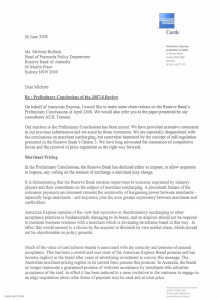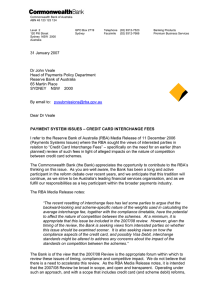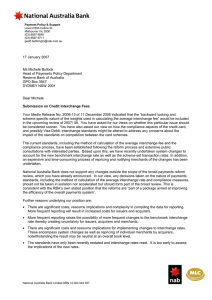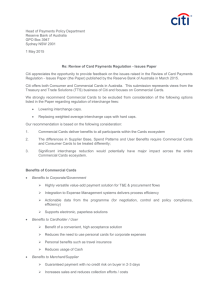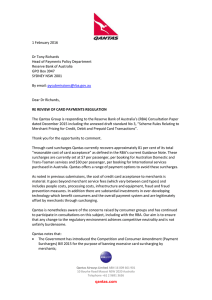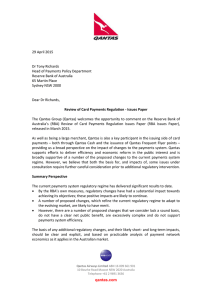31 August 2007 Ms Michele Bullock Head of Payments Policy Department
advertisement
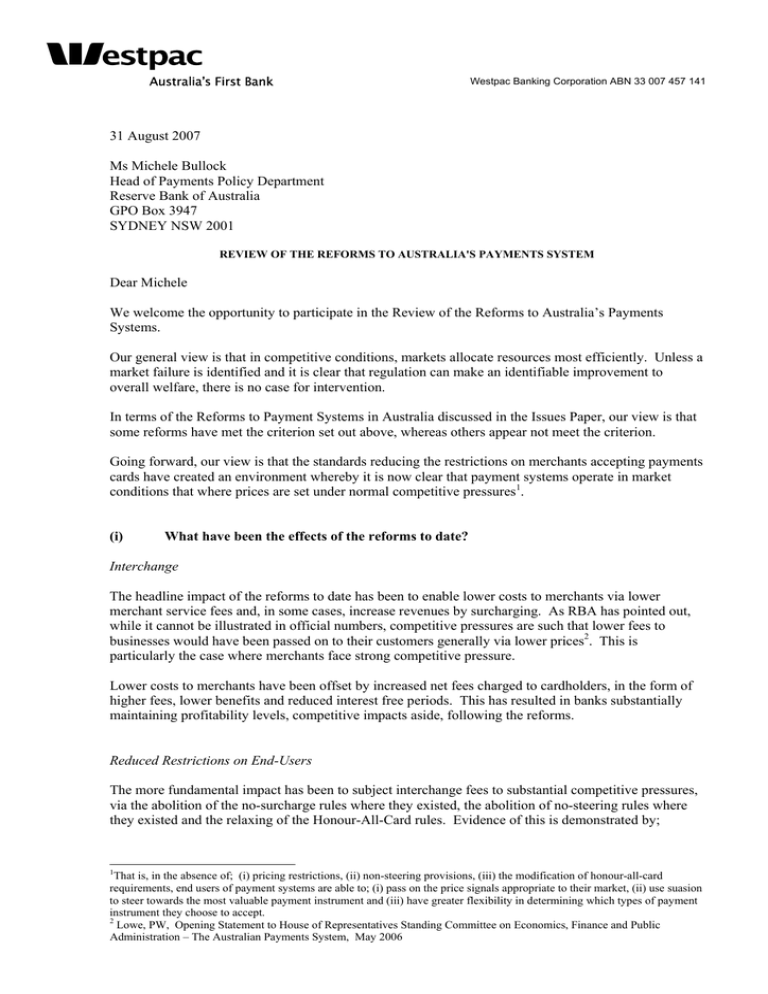
Westpac Banking Corporation ABN 33 007 457 141 31 August 2007 Ms Michele Bullock Head of Payments Policy Department Reserve Bank of Australia GPO Box 3947 SYDNEY NSW 2001 REVIEW OF THE REFORMS TO AUSTRALIA'S PAYMENTS SYSTEM Dear Michele We welcome the opportunity to participate in the Review of the Reforms to Australia’s Payments Systems. Our general view is that in competitive conditions, markets allocate resources most efficiently. Unless a market failure is identified and it is clear that regulation can make an identifiable improvement to overall welfare, there is no case for intervention. In terms of the Reforms to Payment Systems in Australia discussed in the Issues Paper, our view is that some reforms have met the criterion set out above, whereas others appear not meet the criterion. Going forward, our view is that the standards reducing the restrictions on merchants accepting payments cards have created an environment whereby it is now clear that payment systems operate in market conditions that where prices are set under normal competitive pressures1. (i) What have been the effects of the reforms to date? Interchange The headline impact of the reforms to date has been to enable lower costs to merchants via lower merchant service fees and, in some cases, increase revenues by surcharging. As RBA has pointed out, while it cannot be illustrated in official numbers, competitive pressures are such that lower fees to businesses would have been passed on to their customers generally via lower prices2. This is particularly the case where merchants face strong competitive pressure. Lower costs to merchants have been offset by increased net fees charged to cardholders, in the form of higher fees, lower benefits and reduced interest free periods. This has resulted in banks substantially maintaining profitability levels, competitive impacts aside, following the reforms. Reduced Restrictions on End-Users The more fundamental impact has been to subject interchange fees to substantial competitive pressures, via the abolition of the no-surcharge rules where they existed, the abolition of no-steering rules where they existed and the relaxing of the Honour-All-Card rules. Evidence of this is demonstrated by; 1 That is, in the absence of; (i) pricing restrictions, (ii) non-steering provisions, (iii) the modification of honour-all-card requirements, end users of payment systems are able to; (i) pass on the price signals appropriate to their market, (ii) use suasion to steer towards the most valuable payment instrument and (iii) have greater flexibility in determining which types of payment instrument they choose to accept. 2 Lowe, PW, Opening Statement to House of Representatives Standing Committee on Economics, Finance and Public Administration – The Australian Payments System, May 2006 (i) (ii) the increased diversity of the domestic interchange regimes, which have increased from 2 domestic card scheme interchange rates, prior to the October 2003 to the 40-plus interchange rates in place today3, the introduction of surcharging, with the majority of large, medium and small merchants at least considering surcharging. The impact is that pricing signals are no longer suppressed and are visible to all end-users wishing to avail themselves of them. According to the East & Partners report 74% of corporate merchants, 70% of commercial merchants and 60% of SME merchants are surcharging today, or are planning to do so or are considering doing so4. Those merchants who do not perceive the value of card acceptance in the absence of surcharging have the option to surcharge their customers or steer them towards less costly payment methods. Where the value of card acceptance is high enough without surcharging at current interchange rates, merchants do not surcharge. With interchange levels currently regulated at potentially a lower than equilibrium5 rate, it is likely that most merchants will not surcharge. However given the competitive environment that has been generated by RBA’s reforms, if interchange is deregulated, the level of surcharging is likely to be positively correlated with the level of interchange rates. Any other conclusion appears to sit uncomfortably with the normal dynamics of a competitive marketplace. Another piece of evidence demonstrating the competitive tension introduced by these reforms has been for some larger merchants directly to influence lower interchange rates that apply to their business6. While we are not privy to these negotiations, it seems reasonable to conclude that the increased bargaining power of merchants generated under by these RBA reforms have been enabled this outcome. (ii) (iii) What is the case for ongoing regulation of interchange fees, access arrangements and scheme rules, and what are the practical alternatives to the current regulatory approach? And if the current regulatory approach is retained, what changes, if any, should be made to standards and access regimes? Our general preference is for fewer restrictions and enhanced competitive neutrality between the payment systems currently being considered in this Review. In the competitive market for payments in Australia, allowing the market to function unhindered the best model to enhance overall welfare. Unless regulation can improve on market outcomes with a high level of certainty, the risk of unintended costs is high. Our view is that the ongoing regulation of access arrangements and any scheme rules that inhibit competition are justified. In particular, access arrangements that balance the competitive threat of new entrants against the risk of loss of confidence in the payment system – as the current access arrangements do – are important and valuable for the economy. The exception is the existing regulation of interchange fees. It is acknowledged that price regulation is controversial7, and on this basis our view is that it needs to be continually reviewed and justified. Our reading of the evidence available is that the interventions removing the no-surcharge rule, ensuring that no-steering rules are removed and modifying the Honour-All-Cards rules, have substantially changed market conditions. The case for interchange fee regulation in 2002, which was based on (i) suspicions of a non-competitive merchant acquiring market, with (ii) no history of surcharging, can no longer be made in today’s market conditions. This is particularly so, as there is no certainty that the existing 3 Rates are listed on Visa’s and Mastercard’s websites. East & Partners (2006) 5 By an equilibrium rate we mean a volume maximising rate, given the competitive pressures on the rate. 6 The rates are listed of the websites of Visa and Mastercard. 77 Lowe, PW, Opening Statement to House of Representatives Standing Committee on Economics, Finance and Public Administration – The Australian Payments System, May 2006 4 regulation is welfare enhancing. RBA has acknowledged that there is an absence of guidance as to what the socially optimal set of interchange rates would be8. The Case for Interchange Regulation in 2002 Compared to Today In 2002 when designing the current package of reforms to address the above issue, RBA considered an option which removed pricing restrictions on merchants and formalised access conditions for new competitors, but did not regulate interchange. This was referred to as Option (ii)9, which was consistent with the neutrality hypothesis that has been consistently supported by prominent academics Joshua Gans and Stephen King10. RBA rejected this option (ii) on the basis that it; “is unlikely to create a strong competitive environment quickly. Such an environment requires the emergence of a credible threat of entry to the acquiring market by one or more non-traditional participants of substance, and the establishment of merchant freedom to charge according to the means of payment as an effective discipline on merchant service fees.11” The evidence is that both of these conditions have now been met. The merchant acquiring market is competitive, demonstrated by the market fully competing away the reduced interchange cost, and merchant surcharging is widespread. Competitive Merchant Acquiring Market: The Merchant Acquiring market has proven itself to be competitive. The reduction in interchange costs has been fully passed on to merchants and indeed margins have fallen. Official data (published by RBA) shows that MSFs have fallen by 60bps (140bps to 80bps), while over the same period that domestic interchange has fallen by 45bps (95bps to 50bps). This is offset by a 3bp increase in “Other Merchant Fees”, resulting in a reduction in MSF margin over interchange of 12bps. Further, a substantial new competitor, First Data International (FDI)12 has entered the merchant acquiring market via an alliance with HBOS (trading as BankWest in Australia). We are not aware of any arguments that state that the merchant acquiring business is not competitive, and these numbers certainly do not support any such argument. Merchant freedom to surcharge is established: Merchant surcharging is widespread. The introduction of surcharging by some major companies in Australia publicly paved the way for surcharging. As most businesses have relationships of some sort with these major companies, businesses quickly became aware of their new rights. According to the East & Partners report 74% of corporate merchants, 70% of commercial merchants and 60% of SME merchants are surcharging today, planning to do so or are considering doing so. Given the high volume of card transactions this represents, our assessment is that this (i) represents strong evidence that the establishment of merchant freedom to surcharge has occurred, and (ii) demonstrates a high level of pricing tension for card schemes in setting interchange rates. This seems to concur with RBA’s assessment of the impact of surcharging expressed as follows, “The higher costs of credit cards will no longer need to be built into the prices of goods and services paid by all consumers, whether or not they pay by credit card. Overall, the community will benefit from more efficient price signals.”13 8 Lowe PW and MacFarlane IJ (2005), Payments System Reform: The Australian Experience, Remarks prepared for Federal Reserve Bank of Kansas City Conference on 'Interchange Fees in Credit and Debit Card Industries: What Role for Public Authorities?' Santa Fe - 4–6 May 2005 9 RBA (2002), Reform of Credit Card Schemes in Australia IV, Final Reforms and Regulation Impact Statement, August 2002, p9. 10 Joshua S. Gans and Stephen P King (2003) "The Neutrality of Interchange Fees in Payment Systems," Topics in Economic Analysis & Policy: Vol. 3 : Iss. 1, Article 1. 11 RBA (2002), Reform of Credit Card Schemes in Australia IV, Final Reforms and Regulation Impact Statement, August 2002, p33. 12 According to its press release announcing the alliance on 6 September 2005, FDI supports 4.1 million merchant locations globally. 13 RBA Press Release December 2002, Standard on Merchant Pricing. Summary Interchange fee regulation remains a contentious issue and the conditions supporting the justification for regulation of interchange fees in 2002 are no longer in place. On these bases, our conclusion is that the standards regulating interchange fees should be removed. We would be happy to discuss these views further with you. Yours Sincerely Alexandra Holcomb General Manager Working Capital & Trade Solutions
